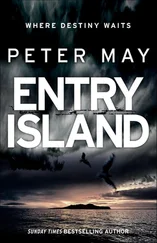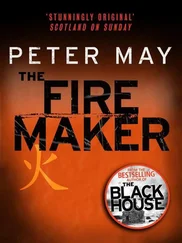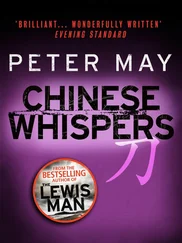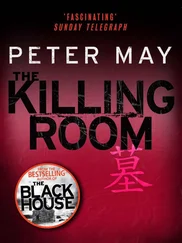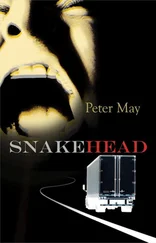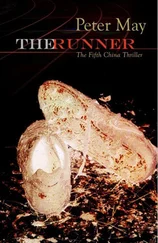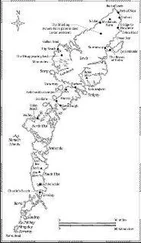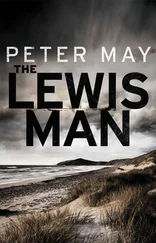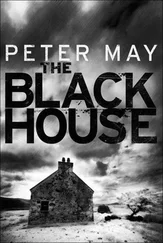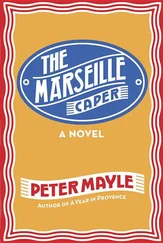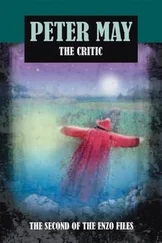Peter May - The Fourth Sacrifice
Здесь есть возможность читать онлайн «Peter May - The Fourth Sacrifice» весь текст электронной книги совершенно бесплатно (целиком полную версию без сокращений). В некоторых случаях можно слушать аудио, скачать через торрент в формате fb2 и присутствует краткое содержание. Год выпуска: 2012, Издательство: Quercus, Жанр: Триллер, на английском языке. Описание произведения, (предисловие) а так же отзывы посетителей доступны на портале библиотеки ЛибКат.
- Название:The Fourth Sacrifice
- Автор:
- Издательство:Quercus
- Жанр:
- Год:2012
- ISBN:нет данных
- Рейтинг книги:4 / 5. Голосов: 1
-
Избранное:Добавить в избранное
- Отзывы:
-
Ваша оценка:
- 80
- 1
- 2
- 3
- 4
- 5
The Fourth Sacrifice: краткое содержание, описание и аннотация
Предлагаем к чтению аннотацию, описание, краткое содержание или предисловие (зависит от того, что написал сам автор книги «The Fourth Sacrifice»). Если вы не нашли необходимую информацию о книге — напишите в комментариях, мы постараемся отыскать её.
The Fourth Sacrifice — читать онлайн бесплатно полную книгу (весь текст) целиком
Ниже представлен текст книги, разбитый по страницам. Система сохранения места последней прочитанной страницы, позволяет с удобством читать онлайн бесплатно книгу «The Fourth Sacrifice», без необходимости каждый раз заново искать на чём Вы остановились. Поставьте закладку, и сможете в любой момент перейти на страницу, на которой закончили чтение.
Интервал:
Закладка:
On the screen, semi-naked labourers tramped clay underfoot before pounding it with great clubs and setting it in moulds to make the warriors and horses. The body parts were then assembled, and overlaid with hand-carved armour and delicately shaped faces — each one different, unique. Hair was sculpted in pleats or piled high, fine detail worked even into the treads of their boots. Warriors were divided into generals and officers, foot soldiers and kneeling archers, charioteers, and then fired in huge kilns. All around her Margaret saw Terracotta Warriors standing in rows as artists painted them in vivid primary colours.
‘Are these real?’ she whispered.
Michael laughed. ‘No. They are exact reproductions, handcrafted from the same clay as the originals, and fired at the same temperature. You can buy them, full-sized, have them shipped to America for a couple of thousand dollars to stand in your garden. Most people wouldn’t be able to tell the difference between the reproduction and the real thing. They did paint the originals, though. Just like that,’ he said, nodding towards the screen.
Margaret said, ‘In all the photographs I’ve seen, they just look sort of clay-coloured.’
Michael said, ‘The warriors were buried for more than two thousand years. The paint simply didn’t survive. The clay colour is just a coating of dry, dusty earth. Underneath they are a sort of bluish black, as they were when they came out of the kilns.’
Labourers, their bodies glistening with sweat, dug the pits to house the warriors. Great beams were raised to support the roofs. Then the warriors were put in place, arrayed in battle formation, between high walls of rammed earth. Real weapons were placed in their hands — swords, bows, spears — and then logs laid overhead to form the roof which was covered with straw matting and then buried under tons of earth. The shadowy figures of the warriors were swallowed into blackness.
And then suddenly the screen was afire with battle again. The voice of the commentator relating the story rose above orchestral crescendos.
‘What’s happening now?’ Margaret asked.
‘A peasant uprising, a year after Qin died. They sacked his palace and broke into the three chambers containing the warriors and stole their weapons to use against the real army of Qin’s successor.’
The blackness burst violently to life as the peasants smashed their way into the warriors’ chambers, carrying flaming torches that cast long shadows among their terracotta counterparts. As they took the swords and spears from an opposing army fired in clay, they began smashing the serried rows of warriors. The distinctive sound of breaking pottery was sickening. All that work and artistry. All the years it had taken to achieve. Smashed in a few moments of mindless vandalism. Margaret watched, wide-eyed, as the peasants set fire to the pits, roof timbers blazing and then caving in on the army below.
From its pitch of excitement, the orchestra swooped to a meandering, tranquil melody of violins to match the sudden pictures of peaceful, open countryside that now surrounded them in the shadow of a hill that rose to a central peak.
‘That’s the tumulus of Qin’s mausoleum,’ Michael said. ‘The one they are afraid to open because of the rivers of mercury. The year is 1974. China is still in the throes of the Cultural Revolution.’ A group of peasants in Mao suits was digging in an open field. ‘These guys were digging a well, when suddenly they started unearthing terracotta heads and hands. The first fragments of a great army that had remained buried for more than two millennia.’
Margaret said, ‘You know, you should think about doing this sort of thing for a living. You might be quite good at it.’
He laughed and took her arm. ‘Come on,’ he said.
‘But it’s not finished yet.’
‘Doesn’t matter. Let’s go see the real thing.’
Outside the auditorium, they blinked in the bright sunlight. The huge concourse was crowded with tourists come to see the Eighth Wonder of the World: busloads of Western tour groups, parties of Chinese schoolchildren, families from all over the Middle Kingdom, from every walk of life; all drawn by the extraordinary phenomenon of the Terracotta Warriors, housed in three huge halls constructed over the pits where they had been found.
As they crossed the concourse Michael said, ‘What happened after they discovered the warriors was a comedy of errors. The officials and cadres at the local cultural centre didn’t seem to think the find was worth telling anyone about. They dragged some bits and pieces off to the centre and started reassembling three of the figures, patching them together and then putting them on display. It was only when a visiting journalist wrote an article about it, months later, that the authorities found out. They immediately put the whole site under state protection, and in 1976 built the first of the exhibition halls over the biggest of the pits — Pit No. 1.’ He inclined his head towards the huge domed construction that loomed over them, and took Margaret’s arm, led her up steps and through the pillared entrance.
He spoke to an attendant, who hurried off, and they took a seat in the entrance hall, beneath big squares of yellow light that fell through the glass roof and dazzled on the marble floor. ‘Someone will come and get you in a minute,’ he said. ‘Then I’m going to have to go off to my meeting.’
Margaret flipped through the pages of a book she had bought on the way into the auditorium. It was filled with photographs of the three pits, and an account of the excavations by the lead archaeologist, Yuan Zhongyi. She said. ‘I thought there were only three chambers.’
‘There are,’ Michael said.
‘That’s not what it says in here.’ She read from Yuan Zhongyi’s account: ‘ Our drilling also revealed a fourth pit at about 20 metres north of the middle part of Vault 1 .’
‘Sure,’ Michael said. ‘But the pit was empty, filled with sand and silt. They figured that the fourth chamber was never finished because the workers all got sent off to fight against the peasant uprising.’
She read on, ‘ As no clay figures have been found in this pit, it is not counted in the vaults of the terracotta army. Generally we speak only of the other three .’ She cocked an eyebrow at Michael. ‘Bet that pissed them off. All that digging and the damn thing turns out to be empty.’
‘That’s archaeology,’ Michael said. ‘You can spend years on something and get nowhere. Then start again a couple of metres to one side or the other and discover a whole civilisation.’
A small man with a shock of spiky black hair laced with streaks of steel-grey, came smiling through the squares of sunlight, his hand outstretched. He shook Michael’s hand warmly and they exchanged greetings in Chinese. He was a man perhaps in his middle fifties, with square tortoiseshell glasses on a smooth, unlined face. He wore an open-necked white shirt loose over dark slacks, and blue-cloth rubber-soled shoes.
‘Margaret,’ Michael said, turning to her, ‘this is Mr Lao Chuanfang. He is one of the most experienced archaeologists working on the excavation.’
His handshake was dry and firm, and his eyes sparkled. ‘How d’you do, Miss Margaret,’ he said, bowing his head slightly.
‘It’s very good of you to look after me like this,’ Margaret said, embarrassed. ‘But it’s really not necessary. I could just as easily wait here for Michael.’
‘No, no,’ said Mr Lao. ‘It my pleasure. Mr Michael is ve-ery good friend of Chinese people.’
‘Well, one or two of them, anyway,’ Michael said, grinning. He checked his watch. ‘Look, I’ve got to go, Margaret. I’ll come and get you when I’ve finished my business. Take good care of her, Mr Lao.’ He winked at her and hurried off.
Читать дальшеИнтервал:
Закладка:
Похожие книги на «The Fourth Sacrifice»
Представляем Вашему вниманию похожие книги на «The Fourth Sacrifice» списком для выбора. Мы отобрали схожую по названию и смыслу литературу в надежде предоставить читателям больше вариантов отыскать новые, интересные, ещё непрочитанные произведения.
Обсуждение, отзывы о книге «The Fourth Sacrifice» и просто собственные мнения читателей. Оставьте ваши комментарии, напишите, что Вы думаете о произведении, его смысле или главных героях. Укажите что конкретно понравилось, а что нет, и почему Вы так считаете.

